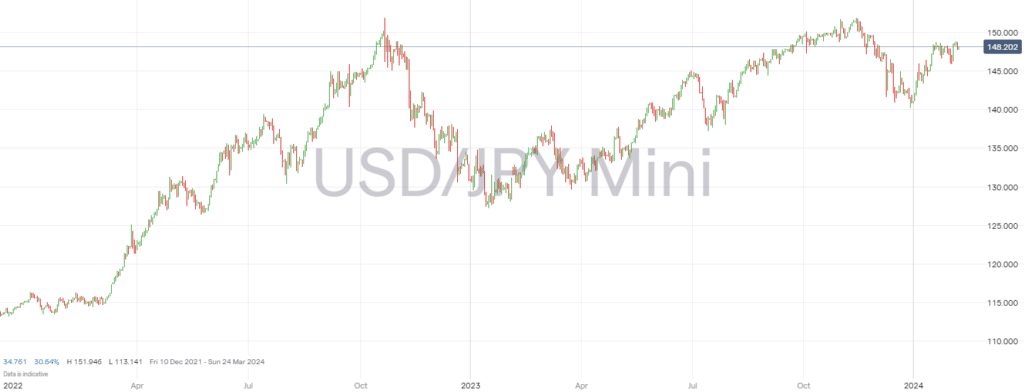The Japanese Yen (JPY) is the third most traded currency. It’s value showcases a complex interplay of economic strategies, market reactions, and governmental interventions. Recent developments highlight Japan’s intricate dance with monetary policies and market forces. This reflects both challenges and strategic responses that could shape its trajectory in the international currency landscape.
The JPY has navigated through a tumultuous period marked by divergent economic policies, heightened inflation rates, and global geopolitical tensions. The USD/JPY pair, in particular, has reflected these dynamics. Federal Reserve’s interest rate hikes aimed at curbing inflation in the U.S. influenced price movements. This has led to a stronger dollar against the yen. The geopolitical landscape has also played a pivotal role in driving investor sentiment towards safe-haven currencies like the yen.
JPY Key Points
- USDJPY Performance: The pair has seen significant fluctuations, with notable changes in response to economic policies, global tensions, and market dynamics.
- Federal Reserve Impact: Interest rate hikes in the U.S. have historically strengthened the dollar against the yen, with adjustments in monetary policy anticipated to have future implications.
- Bank of Japan’s Policy: Maintaining a dovish stance amidst global monetary tightening, with implications for the yen’s performance.
In late 2023 the JPY experienced a significant depreciation. It’s value approached the 150 per dollar, marking its weakest position in 11 months. The Bank of Japan’s (BOJ) cautious stance on altering its ultra-easy monetary policy is the reason for this movement. Add to this the U.S. Federal Reserve’s openness to further tightening. The disparity between Japan and U.S. interest rates, amplified by these policy divergences, has widened, impacting the Yen’s valuation against the dollar.
However, this depreciation prompted discussions around potential interventions. Historically Japan has not shied away from stepping in to adjust the Yen’s value, especially during periods of excessive volatility. However, the threshold for such interventions remains high. The BOJ tends to focus on strategies aimed at curbing speculative excess and ensuring market stability, rather than targeting specific exchange rate levels.
Looking ahead, analysts and investors are closely monitoring the 150 yen per dollar mark. This is a symbolic threshold that could trigger governmental action due to its implications on Japan’s cost of living and economic stability. The decision to intervene, while politically and economically loaded, underscores Japan’s delicate balance between fostering market freedom and safeguarding economic health.
Anticipated JPY Trends for 2024
The Federal Reserve’s potential shift towards lowering interest rates could bolster the yen. Forecasts are suggesting a notable appreciation against the dollar. This comes amidst expectations of a continued economic slowdown in Japan, contrasted with a potential recovery in the U.S. The Bank of Japan‘s (BOJ) policies, particularly its yield curve control (YCC) policy, are anticipated to undergo further scrutiny and possible adjustments in response to inflation and economic growth challenges.
Monetary Policies and Their Impact on JPY
The interplay between the Fed’s hawkish stance and the BOJ’s dovish policies has significantly influenced the USD/JPY exchange rate. Modifications in these policies will be closely watched by investors for their potential impact on currency valuations. The Fed’s interest rate decisions, alongside the BOJ’s approach to managing inflation and growth, will remain critical factors in the yen’s performance against the dollar and other major currencies.
The Role of Global Trade and Geopolitical Events
Trade dynamics and global events have historically impacted the yen. Shifts in global trade relations, supply chain disruptions, and regional conflicts often affect the JPY. The yen’s valuation against the dollar and other currencies will continue to be influenced by these factors, alongside Japan’s efforts to diversify trade partners and navigate economic challenges.
Don’t Trade Before you see this!
We consulted our team of experts and put together 10 tips to help improve your trading.
These tips could help make you a better trader – and we’re giving them away for free!
Related Articles


 Between 74-89% of CFD traders lose
Between 74-89% of CFD traders lose  Your capital is at risk
Your capital is at risk  Your capital is at risk
Your capital is at risk  Your capital is at risk
Your capital is at risk